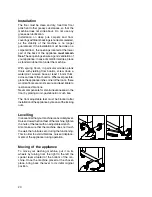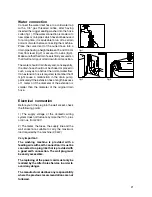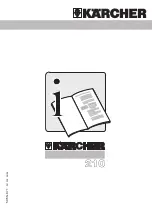
12
HINTS AND TIPS
Washing hints
You are advised not to leave your laundry too long,
especially when damp. Damp laundry produces
moult and unpleasant smells.
Moult stains cannot be removed.
Sort your laundry.
Study carefully the chart in this booklet explaining
the symbols used on clothes labels (see page 14).
The following points are particularly important :
- a line under the bowl means that the garment
cannot be washed using programmes for resistant
fabrics such as cotton and linen;
- do not mix coloured garments with whites;
- anticrease materials like polyester/cotton should
be treated as synthetics;
- non-resistant fabrics like acrylic and most curtain
materials should be treated as delicate fabrics;
- the wool programme is designed specifically for
pure new wool. Other types of wool and wool
mixtures may shrink or felt if machine-washed.
Woollen garments should be spun briefly
immediately after washing.
Prewash
Prewash is not normally necessary. Your new
washing machine combined with modern
detergents will give perfect washing results without
prewash, thus saving energy, time, water and
detergent.
However, when the laundry is particularly dirty
(for example if you have to wash mechanics'
overalls or butchers' aprons), you are advised to
use prewash with a biological detergent.
Temperatures
We suggest that white cotton and linen, if it is not
excessively soiled, can be washed at 60° instead
of 90°C. There should be no reduction in perfor-
mance, but there will be an energy saving of
approximately 30%.
The same applies to a lesser extent to fast coloured
garments.
They usually require a temperature of 60°C but if
they are not excessively dirty, you will have
satisfactory results at 40°C.
Garments with non-fast colours should not be
washed at temperatures above 40°C. If fast and
non-fast colours are washed together, they should
be treated as non-fast colours and therefore the
temperature should not exceed 40°C.
Resistant white and coloured synthetics can
normally be washed at 60°C but also in this case
40°C is sufficient if the laundry is not excessively
dirty.
Delicate synthetics, synthetics with non-fast
colours and woollen garments must never be
washed above 40°C.
As you already know, your washing machine can
also wash with cold water. However, it must be
remembered that the detergents currently on the
market have not been designed for cold washes
and that in winter, when the water is very cold,
they may not dissolve adequately.
We suggest the use of liquid detergents.
How much laundry can be washed
in one load?
Strictly speaking you should always weigh your
laundry.
The drum will take a maximum of 5 kg of cotton and
linen. For synthetics and delicate fabrics, the
maximum load is 2,5 kg and for wool, 1 kg.
As weighing can be complicated, we suggest you
estimate the weight according to how full the drum
is:
cotton and linen : drum full not too tighty packed
resistant synthetics : no more than 2/3 of the
drum
delicate fabrics and wool : no more than 1/2 of
the drum.
Before placing the laundry in the
machine:
- mend all tears, holes and ladders;
- secure loose buttons and close poppers and
zips;
- do not wash frayed garments - mend hems
before washing;
- remove all small objects from pockets. Nails,
pins, clips and similar objects can seriously damage
your washing machine and laundry;
- remove curtain hooks;
- wash coloured garments and in particular those
with non-fast colours separately when washing for
the first time. They are likely to lose colour the first
time they are washed.
- treat obstinate stains such as grass, rust, tar,
paint, ink etc. with a stain remover before washing.







































